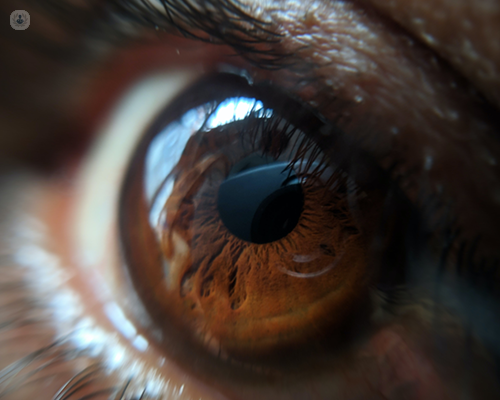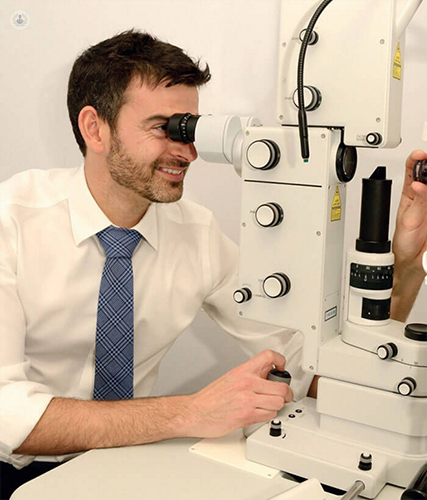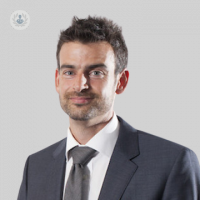Benefits of selective laser trabeculoplasty (SLT)
Escrito por:Selective laser trabeculoplasty (SLT) is a very safe and effective procedure for treating glaucoma and ocular hypertension (OHT). Mr Dan Lindfield is a leading ophthalmologist and expert in all laser therapies for glaucoma and ocular hypertension. Learn from this multi-award-winning consultant ophthalmologist about why SLT is becoming the first choice for lowering eye pressure worldwide.

What is selective laser trabeculoplasty?
Selective laser trabeculoplasty (SLT) is a safe first-line option for treating glaucoma and ocular hypertension. The result is that medications are gradually becoming second-line treatments in favour of SLT, a simple and painless procedure that can provide years of control for pressure in the eye.
It’s an outpatient procedure (meaning it’s not an “operation”, you don’t need to go to an operating theatre and you don’t need an overnight stay) and often takes less than five minutes per eye. Furthermore, recovery times are quick, often 1-2 days.

How does SLT compare with other laser techniques?
SLT (selective laser trabeculoplasty)
SLT is the most commonly performed laser trabeculoplasty worldwide. It works by gently ‘tickling’ the cells to encourage the drainage of aqueous humour (the fluid which maintains pressure in the eye). By encouraging the drainage of fluid, eye pressure is reduced. A benefit is that, unlike older laser treatments, SLT doesn’t cause damage to the trabecular meshwork – which is responsible for draining aqueous humour from the eye. As it does not cause any physical damage to the drains, it is repeatable again and again.
ALT (argon laser trabeculoplasty)
ALT is now considered old technology. This is mostly due to the higher likelihood of side effects because it reduces pressure by structural change/damage to the trabecular meshwork. It is now very rarely used in the UK.
MLT (Micropulse diode laser trabeculoplasty)
MLT has similar effectiveness and risk as SLT, the main difference being that it uses a different laser that switches on and off many times per “shot” and therefore, claims to cause less inflammation and improve safety. Overall, results are very similar to SLT but MLT still requires research to prove if it does indeed cause less inflammation than SLT and if it is as effective.
Why is SLT a good first-line treatment?
As a first method of treatment for glaucoma and ocular hypertension, SLT can provide similar results to eye drops but without the need for daily use. By undergoing SLT, patients can have up to 2-4 years without the need to use daily eye drops - the level of reduction of intraocular pressure is at least equivalent to that of one eye drop medication.
For patients already taking eye drop medicines, SLT can be used as a substitute for one or more of them. This can improve quality of life, side effects, sore eyes and the need for repeat prescriptions.
Furthermore, with SLT the need for invasive eye surgery is reduced and the progression rate of the disease is reduced. Recent research also suggests that SLT seems to reduce the likelihood of developing a cataract.
Are there risks?
While SLT is a very safe procedure, like all medical treatments it is not 100% without risk. However, side effects are either very rare or minimal in terms of severity.
- Mild redness and/or ache: It’s possible to have mild redness or ache in the eye following the procedure but this nearly always settles within a few days. Anti-inflammatory eye drops are provided after the procedure to lessen the duration of redness and ache. These can be taken three times per day for up to 7 days if needed. However, many patients don’t require them.
- Photophobia (sensitivity to light): Just like redness and ache, sensitivity to light settles quickly thanks to the standard post-procedure anti-inflammatory drops.
- A short-term increase in eye pressure: Routine use of preventative eye drops (Apraclonidine) given before and immediately after the SLT procedure and modern laser techniques have reduced this risk to 1 in 800. In the rare scenario that eye pressure rises to an unacceptable level, patients’ are provided with a tablet to bring it back to normal.
- Iris adhesions to the trabecular meshwork: In the majority of safety studies, a 0% rate of damage to the trabecular meshwork was found, with only a 2% rate being found in one of the studies. Macular oedema and corneal oedema are possible but only a handful of cases have ever been reported worldwide.
Having said this, it’s important to remember that the procedure is very safe. Your eye specialist should talk through these risks when you discuss SLT.
Is SLT suitable for me?
In order to find out if SLT is the best course of action for maintaining your eye health, you’ll need a full and honest discussion with your ophthalmologist. They will personalise your treatment plan for your specific case.
With Mr Lindfield, you can be sure that you’ll receive eye care of the highest quality. Visit his profile to learn more and arrange your consultation.


